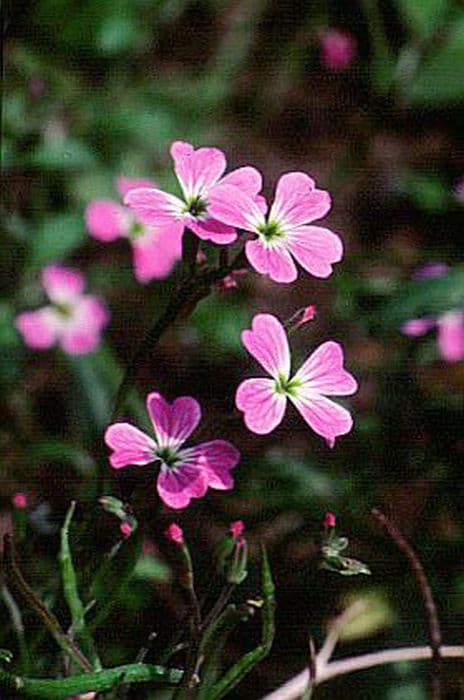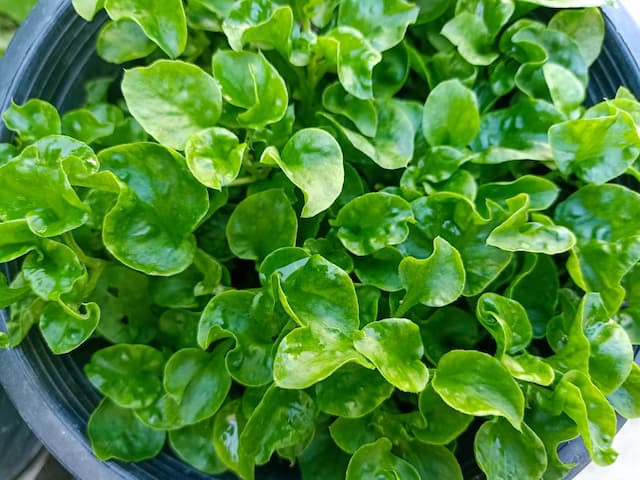Sweet alyssum Lobularia maritima 'Violet Queen'

ABOUT
Lobularia maritima 'Violet Queen', more commonly known as sweet alyssum, presents a lovely display with its masses of tiny, delicate flowers. This particular cultivar, the 'Violet Queen', boasts rich, deep violet blossoms that form dense clusters, creating a carpet-like appearance. The blooms have a sweet, honey-like fragrance that adds to its allure, attracting pollinators such as bees and butterflies to the garden. Its foliage comprises small, narrow leaves, which are often a gray-green hue, providing a subtle backdrop that further accentuates the vibrancy of the violet flowers. The sweet alyssum 'Violet Queen' is a favorite among gardeners for its ability to fill spaces with its cascading habit, spilling over the edges of containers, borders, and walls with a profusion of color that typically lasts from spring through frost.
About this plant
 Names
NamesFamily
Brassicaceae
Synonyms
Sweet Alyssum, Sweet Alison, Seaside Lobularia, Maritime Alyssum
Common names
Alyssum maritimum 'Violet Queen', Alyssum maritimum 'Carpet of Snow'.
 Toxicity
ToxicityTo humans
Sweet alyssum is generally considered non-toxic to humans. It is often used in gardens for its small, fragrant flowers and is not known to cause any adverse health effects if touched or ingested in small quantities. However, as with any plant, individuals may have allergies or sensitivities that could cause mild irritation. There are no commonly reported cases of poisoning from ingesting sweet alyssum.
To pets
Sweet alyssum is also considered non-toxic to pets. It is commonly used in gardens and does not pose a significant risk if pets come into contact with it or ingest small amounts. As with humans, some pets may have allergies or sensitivities resulting in mild gastrointestinal upset upon ingestion, but sweet alyssum is not known to cause serious illness or toxicity.
 Characteristics
CharacteristicsLife cycle
Annuals
Foliage type
Evergreen
Color of leaves
Green
Flower color
Violet
Height
6-12 inches (15-30 cm)
Spread
6-12 inches (15-30 cm)
Plant type
Herb
Hardiness zones
9
Native area
Mediterranean
Benefits
 General Benefits
General Benefits- Attracts Pollinators: The 'Violet Queen' variety of Sweet Alyssum is known to attract butterflies and bees, supporting pollination in the garden.
- Easy to Grow: Sweet Alyssum is a hardy plant that thrives in a range of conditions and is relatively easy for beginner gardeners to grow.
- Drought Tolerant: Once established, it is quite tolerant of drought, reducing the need for frequent watering.
- Ground Cover: Sweet Alyssum can serve as an effective ground cover, suppressing weeds and reducing soil erosion.
- Landscape Versatility: With its violet-colored blooms, it adds an aesthetic appeal to borders, containers, and hanging baskets.
- Season-Long Blooms: Sweet Alyssum flowers for an extended period from spring to frost, providing long-lasting color and coverage.
- Compact Growth: Its compact, low-growing habit makes it suitable for small spaces and as an edging plant.
- Fragrant Flowers: The plant is known for its sweet, honey-like fragrance which can be a delightful addition to any outdoor space.
 Medical Properties
Medical PropertiesThis plant is not used for medical purposes.
 Air-purifying Qualities
Air-purifying QualitiesThis plant is not specifically known for air purifying qualities.
 Other Uses
Other Uses- Lobularia maritima, commonly known as sweet alyssum, can be used as a natural dye source, providing a range of soft yellow to green hues for fabric and yarn depending on the mordant used.
- In companion planting, sweet alyssum attracts beneficial insects like hoverflies and predatory wasps, which can help control garden pests on neighboring crops.
- The plant's ability to tolerate salt spray and sandy soils makes it a suitable groundcover to stabilize coastal and roadside areas against erosion.
- Cooking recipes sometimes utilize the flowers of sweet alyssum as a delicate garnish, adding a mild floral aroma to salads and desserts.
- Craft enthusiasts might use dried sweet alyssum flowers in potpourris, adding color and texture to the mix while retaining a gentle fragrance.
- Sweet alyssum can be used in ornamental wreaths and floral arrangements, providing delicate textures and a honey-scented fragrance to the compositions.
- In landscape design, sweet alyssum is used to create a "spiller" effect in container gardens, where it spills over the sides to soften the look of the arrangement.
- The plant has been traditionally used in wedding bouquets and as décor for festive occasions due to its fragrance and small, dense flowers.
- Photographers may use sweet alyssum as a foreground plant in garden photography to add depth and interest to their compositions.
- Fine artists may use sweet alyssum as inspiration for botanical illustrations or as real-life models for painting because of their vivid colors and delicate forms.
Interesting Facts
 Feng Shui
Feng ShuiThe Sweet Alyssum is not used in Feng Shui practice.
 Zodiac Sign Compitability
Zodiac Sign CompitabilityThe Sweet Alyssum is not used in astrology practice.
 Plant Symbolism
Plant Symbolism- Innocence: Lobularia maritima, commonly known as sweet alyssum, often symbolizes innocence due to its delicate small flowers and gentle fragrance.
- Beauty: The 'Violet Queen' variety, with its rich violet color, represents beauty and grace in the language of flowers.
- Worth beyond beauty: Sweet alyssum also conveys the message that beauty is not just skin deep, signifying a depth of character and inner beauty.
 Water
WaterSweet Alyssum prefers even moisture, so it should be watered regularly to keep the soil lightly moist but not soggy. Depending on the climate and weather conditions, this usually equates to watering approximately once a week, giving the plant around 1 gallon of water each time. In hot and dry weather, it may require more frequent watering, possibly every few days to prevent the soil from drying out completely. During rainy seasons or cooler temperatures, watering can be reduced. It's important to ensure that the plant has good drainage to prevent root rot.
 Light
LightSweet Alyssum thrives in full sun to partial shade. The plant will perform best when it receives at least 6 hours of direct sunlight per day. An ideal spot would be in a garden that gets plenty of morning sunlight with some afternoon shade to protect it from the intense heat of the day, especially in hotter climates.
 Temperature
TemperatureSweet Alyssum prefers moderate temperatures and can generally survive minimum temperatures down to 40 degrees Fahrenheit, but it thrives in temperatures ranging from 60 to 75 degrees Fahrenheit. The plant can tolerate a maximum temperature of around 85 degrees Fahrenheit, beyond which it may start to show signs of stress.
 Pruning
PruningPruning Sweet Alyssum is necessary to maintain its shape and encourage bushier growth and more blooms. Trim back the plant lightly after its first flowering session to promote a second bloom. Pruning should be done as needed, generally several times throughout the growing season. The best time for pruning is after the plant has finished a wave of blooming.
 Cleaning
CleaningAs needed
 Soil
SoilSweet Alyssum 'Violet Queen' grows best in well-draining, loamy soil with a pH between 6.0 and 7.0. A mix of two parts garden soil, one part compost or well-rotted manure, and one part sand or perlite is ideal to support healthy growth. This combination ensures good drainage and fertility, essential for vibrant flowering.
 Repotting
RepottingSweet Alyssum 'Violet Queen' is usually grown as an annual, so repotting may not be necessary. If grown as a perennial in warmer climates, repotting every 2-3 years should suffice, or when the plant outgrows its current container.
 Humidity & Misting
Humidity & MistingSweet Alyssum 'Violet Queen' thrives in average humidity conditions typical of outdoor environments. It tolerates a range of humidity levels, making it very adaptable, but does not require high humidity to flourish.
 Suitable locations
Suitable locationsIndoor
Place in sunny spot, ensure good airflow, water moderately.
Outdoor
Full sun to partial shade, well-drained soil, regular watering.
Hardiness zone
5-9 USDA
 Life cycle
Life cycleSweet Alyssum 'Violet Queen' begins its life as a seed, which, when sown in fertile, well-drained soil and given appropriate warmth and moisture, will germinate typically within 7 to 14 days. Once the seedlings emerge, they will develop true leaves and continue to grow, forming a low-growing mat of foliage. As the plant matures, it produces clusters of tiny, fragrant violet flowers that attract beneficial insects and pollinators. Sweet Alyssum 'Violet Queen' blooms profusely from spring to fall, with the peak flowering season occurring in cooler temperatures. Throughout its life, it may require deadheading to encourage further blooming and to maintain its compact shape. At the end of the growing season, if conditions allow, it may self-seed to produce new plants for the following year.
 Propogation
PropogationPropogation time
Spring-Summer
Sweet Alyssum 'Violet Queen' can be propagated primarily through seeds. Sowing seeds can be done in late winter to early spring indoors or directly outdoors after the danger of frost has passed. To propagate from seed, sprinkle the tiny seeds on the surface of a well-draining seed starting mix, gently pressing them into the soil as they need light to germinate. Keep them at a temperature of around 70°F (21°C), and maintain the soil moisture until germination, which typically occurs in 7 to 14 days. Once seedlings are large enough to handle and after all risk of frost is gone, they can be transplanted to their final location in the garden, spaced about 6 to 9 inches (15 to 23 centimeters) apart to allow for spreading and adequate air circulation.








![Wallflower [Winter Orchid]](/_next/image?url=https%3A%2F%2Fplants-admin.emdemapps.com%2Fimages%2Fplants%2F%2Fimages%2F604b62b20ab9a.png&w=640&q=75)
